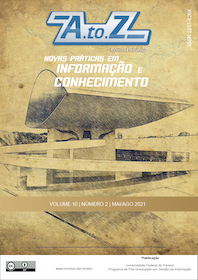Usando ClassDojo para motivar a participação de crianças nas aulas online de inglês durante a pandemia do Covid-19: um estudo de caso
DOI:
https://doi.org/10.5380/atoz.v10i2.78711Palavras-chave:
ClassDojo, Participação nas aulas, Motivação, Aulas online, COVID-19Resumo
Introdução: A pandemia da COVID-19 mudou a forma como as aulas eram ministradas em todo o mundo. Os professores equatorianos foram obrigados a implementar aulas de forma síncrona e assíncrona. Consequentemente, todo o conteúdo foi adaptado para este novo tipo de aula. Por outro lado, os alunos, apresentam cansaço durante as aulas, desmotivação para aprender e infelicidade com a nova modalidade. Estudos têm demonstrado as vantagens do Computer Assisted Language Learning (CALL) para motivar os alunos. Método: Este estudo de caso teve como objetivo investigar a eficiência do ClassDojo para motivar a participação de alunos equatorianos durante as aulas online de inglês. Uma amostra de 29 alunos do sexto ano de uma escola particular, com idades entre 9 e 11 anos, participou desta pesquisa. Os dados foram coletados durante quatro meses de aulas (agosto a novembro de 2020) por meio de provas (pré e pós), entrevista e diário do professor. Resultados: Após a implementação do aplicativo, os participantes apresentaram diferença significativa entre o pré-teste (M = 2,03, DP = 1,26) e o pós-teste (M = 7,28, DP = 1,69) com p = 0,00 e d de Cohen = 3,52. Os resultados recolhidos do pré e pós-teste revelaram que o ClassDojo motivou a participação dos alunos nas aulas. Os resultados da entrevista mostraram as opiniões positivas dos alunos sobre o uso do ClassDojo. Conclusões: Este aplicativo permitiu aos participantes aprender, interagir e se divertir ao mesmo tempo. Esta pesquisa é dirigida a professores que têm aulas online e desejam aumentar a participação dos alunos.
Referências
Adams, A., Randall, S., & Traustadóttir, T. (2015). A tale of two sections: An experiment to compare the effectiveness of a hybrid versus a traditional lecture format in introductory microbiology. CBE Life Sciences Education, 14(1), 1-8. https://doi.org/10.1187/cbe.14-08-0118
Alqurashi, E. (2019). Predicting student satisfaction and perceived learning within online learning environments. Distance Education, 40(1), 133-148. https://doi.org/10.1080/01587919.2018.1553562
Armstrong, M., & Boud, D. (1983). Assessing participation in discussion: An exploration of the issues. Studies in Higher Education, 8(1), 33–44. https://doi.org/10.1080/03075078312331379101
Auster, C., & MacRone, M. (1994). The classroom as a negotiated social setting: An empirical study of the effects of faculty members' behavior on students' participation. Teaching Sociology, 22, 289-300. https://doi.org/10.2307/1318921
Baber, H. (2020). Determinants of Students' Perceived Learning Outcome and Satisfaction in Online Learning during the Pandemic of COVID19. Journal of Education and eLearning Research, 7(3): 285-292. https://ssrn.com/abstract=3679489
Bao, W. (2020). COVID-19 and online teaching in higher education: A case study of Peking University. Human Behavior and Emerging Technologies, 2(2), 113-115.: https://doi.org/10.1002/hbe2.191
Barata, G., Gama, S., Jorge, J., & Gonçalves, D. (2013). Improving participation and learning with gamification. In L. Nacke, K. Harrigan, & N. Randall (Eds.), Proceedings of International Conference on Gameful Design, Research, and Applications (pp. 10–17). ACM.
Baxter, P., & Jack, S. (2008). Qualitative case study methodology: Study design and implementation for novice researchers. The Qualitative Report, 13(4), 544-559. http://www.nova.edu/ssss/QR/QR13-4/baxter.pdf
Bean, J., & Peterson, D. (1998). Grading classroom participation. New Directions for Teaching and Learning, 74(15), 33 40. https://doi.org/10.1002/tl.7403
Bisson, C., & Luckner, J. (1996). Fun in Learning: The Pedagogical Role of Fun in Adventure Education. Journal of Experiential Education, 19(2), 108–112. https://doi.org/10.1177/105382599601900208
Bolliger, D. U., Supanakorn, S., & Boggs, C. (2010). Impact of podcasting on student motivation in the online learning environment. Computers & Education, 55(2), 714-722. https://doi.org/10.1016/j.compedu.2010.03.004
Brewer, R., Anthony, L., Brown, Q., Irwin, G., Nias, J., Tate, B. (2013). Using Gamification to Motivate Children to Complete Empirical Studies in Lab Environments. In: 12th International Conference on Interaction Design and Children, pp. 388–391.
Burchfield, C., & Sappington, J. (1999) Participation in classroom discussions. Teaching of Psychology, 26(4), 290–291.
Cáceres-Piñaloza, K. (2020). Educación virtual: Creando espacios afectivos, de convivencia y aprendizaje en tiempos de COVID-19. CienciAméRica, 9(2), 38-44. https://doi:10.33210/ca.v9i2.284
Cetin, H., & Cetin, I. (2018). Views of middle school students about Class Dojo education technology. Acta Didactica Napocensia, 11(3/4), 89-96. https://doi.org/10.24193/adn.11.3-4.7
Cole, M., Feild, H., & Harris, S. (2004). Student learning motivation and psychological hardiness: Interactive effects on students' reactions to a management class. Academy of Management Learning & Education, 3(1), 64-85. https://doi.org/10.5465/amle.2004.12436819
Crawford, M., & MacLeod, M. (1990). Gender in the college classroom: An assessment of the 'chilly climate' for women. Sex Roles, 23, 101-122. https://doi.org/10.1007/BF00289859
Daniels, A. (2004). Composition instruction: Using technology to motivate students to write. Information Technology in Childhood Education Annual, 2004(1), 157-177. https://www.learntechlib.org/primary/p/12898/
Dattilo, J., & Kleiber, D. A. (1993). Psychological perspectives for therapeutical recreation research: the psychology of enjoyment. In J. Marjorie & C. Z. Howe (Eds.), Research in therapeutic recreation: Concepts and methods (pp. 57-76). Venture Publishing.
Deterding, S., Dixon, D., Khaled, R., & Nacke, L. (2011). From game design elements to gamefulness: defining gamification. In Proceedings of the 15th International Academic MindTrek Conference (pp. 9–15).
Dicheva, D., Dichev, C., Agre, G., & Angelova, G. (2015). Gamification in Education: A Systematic Mapping Study. Educational Technology & Society, 18(3), 75–88. www.jstor.org/stable/jeductechsoci.18.3.75
Domínguez, A., Saenz-de-Navarrete, J., de-Marcos, L., Fernández-Sanz, L., Pagés, C., & Martínez-Herráiz, J. J. (2013). Gamifying learning experiences: Practical implications and outcomes. Computers & Education, 63, 380–392. https://doi.org/10.1016/j.compedu.2012.12.020
Dornyei, Z. & Otto, I. (1998). Motivation in action: A process model of L2 motivation. Working Papers in Applied Linguistics 4, 43 – 69. http://eprints.nottingham.ac.uk/id/eprint/39
Friedemann, S.; Baumbach, L. and Jantke, K. (2015). Textbook Gamification - Transforming Exercises into Playful Quests by using Webble Technology. In Proceedings of the 7th International Conference on Computer Supported Education, 2, 116-126. https://doi.org/10.5220/0005489101160126
Gardner, R. (1985). Social psychology and second language learning: The role of attitudes and motivation. London.
Gardner, R., Masgoret, A., Tennant, J., & Mihic, L. (2004). Integrative motivation: Changes during a year-long intermediate level language course. Language Learning, 54(1), 1-34. https://doi.org/10.1111/j.1467-9922.2004.00247.x
Gehlbach, H., & Robinson, C. (2018). Mitigating Illusory Results through Preregistration in Education, Journal of Research on Educational Effectiveness, 11(2), https://doi.org/10.1080/19345747.2017.1387950
Halim, M., Hashim, H., & Yunus, M. (2020). Pupils' motivation and perceptions on ESL lessons through online quiz-games. Journal of Education and E-Learning Research, 7(3), 229-234. https://doi.org/10.20448/journal.509.2020.73.229.234
Harmon-Jones, E., Harmon-Jones, C., & Price, T. (2013). What is approach motivation? Emotion Review, 5(3), 291-295. https://doi.org/10.1177/1754073913477509
Heller, J., Puff, C., & Mills, C. (1985). Assessment of the chilly college climate for women. Journal of Higher Education, 56, 446-461. https://doi.org/10.2307/1981305
Holliday, A. (2005). Doing and writing qualitative research. London: Sage Publications.
Hsu, H., Wang, C., & Levesque-Bristol, C. (2019). Reexamining the impact of self-determination theory on learning outcomes in the online learning environment. Education and Information Technologies, 24(3), 2159-2174. https://doi.org/10.1007/s10639-019-09863-w
Inoue, Y. (2007). Online education for lifelong learning: A silent revolution. In Online education for lifelong learning (pp. 1-27): IGI Global.
Jones, S. (2006). Evaluation of instructor knowledge on structuring and facilitating effective online discourse. The Journal of Educators Online, 3(2), 1-14. https://doi.org/10.9743/jeo.2006.2.1
Krach, S., McCreery, M., & Rimel, H. (2017). Examining Teachers' Behavioral Management Charts: a Comparison of Class Dojo and Paper-Pencil Methods. Contemporary School Psychology, 21(3):267–75. https://doi.org/10.1007/s40688-016-0111-0
Ku, H., Tseng, H., & Akarasriworn, C. (2013). Collaboration factors, teamwork satisfaction, and student attitudes toward online collaborative learning. Computers in Human Behavior, 29(3), 922-929. https://doi.org/10.1016/j.chb.2012.12.019
Lightbown, P., & Spada, N. (1993). How languages are learned. Oxford University Press.
Lin, N. (2014). Assessing Classroom Participation and Performance through Gamification Systems in Foreign Language Classrooms. In M. Searson & M. Ochoa (Eds.), Proceedings of SITE 2014--Society for Information Technology & Teacher Education International Conference (pp. 1772-1777). Association for the Advancement of Computing in Education (AACE). https://www.learntechlib.org/primary/p/131031/
Lowman, J. (1995). Mastering the techniques of teaching. Jossey-Bass.
Lyons, P. (1989). Assessing classroom participation. College Teaching, 37, 36-38. https://doi.org/10.1080/87567555.1989.10532154
Maclean-Blevins, A., & Muilenburg, L. (2013). Using ClassDojo to support student self-regulation. In J. Herrington, A. Couros, & V. Irvine et al. (Eds.), Proceedings of World Conference on Educational Multimedia, Hypermedia and Telecommunications (pp. 1684–1689). Association for the Advancement of Computing in Education. https://www.learntechlib.org/primary/p/112192/
Marks, R., Sibley, S., & Arbaugh, J. (2005). A structural equation model of predictors for effective online learning. Journal of Management Education, 29(4), 531-563. https://doi.org/10.1177/1052562904271199
McKinney, K., & Graham-Buxton, M. (1993). The use of collaborative learning groups in the large class: Is it possible? Teaching Sociology, 21, 403-408. https://doi.org/10.2307/1319092
Mercer, N., & Howe, C. (2012). Explaining the dialogic processes of teaching and learning: The value and potential of sociocultural theory. Learning, Culture and Social Interaction, 1(1), 12–21. https://doi.org/10.1016/j.lcsi.2012.03.001
Michael, F., Maithya, R., & Cheloti, S. (2016). Influence of teacher competency on integration of ICT in teaching and learning in public secondary schools in Machakos. Journal of Education and e-Learning Research, 3(4), 143-149. https://doi.org/10.20448/journal.509/2016.3.4/509.4.143.149
Middleton, J. A., Littlefield, J., & Lehrer, R. (1992). Gifted students' conceptions of academic fun: an examination of a critical construct for gifted education. Gifted Child Quarterly, 36(1), 38-44 https://doi.org/10.1177/001698629203600109
Muthuprasad, T., Aiswarya., S, Aditya, K., & Jha, G. (2020). Students' Perception and Preference for Online Education in India During COVID -19 Pandemic. Social Sciences & Humanities Open, 1-38. http://dx.doi.org/10.2139/ssrn.3596056
Nah, F., Zeng, Q., Telaprolu, V., Ayyappa, A., & Eschenbrenner, B. (2014). Gamification of Education: A Review of Literature. HCI in Business: First International Conference, Crete, Greece. Proceedings. 401-409. http://dx.doi.org/10.1007/978-3-319-07293-7_39
Nelson, M., Oden, K., & Williams, L. (2019). Student motivation to participate in asynchronous online discussions. Journal of Nursing Education and Practice, 9(9), 6-11. https://doi.org/10.5430/jnep.v9n9p6
Precourt, E., & Gainor, M. (2018): Factors affecting classroom participation and how participation leads to a better learning, Accounting Education: 1,100-118. https://doi.org/10.1080/09639284.2018.1505530
Rodrigues, H., Almeida, F., Figueiredo, V., & Lopes, S. L. (2019). Tracking e-learning through published papers: A systematic review. Computers & Education, 136, 87-98. https://doi.org/10.1016/j.compedu.2019.03.007
Saghafi, M. R., Franz, J., & Crowther, P. (2014). An integrated blended model for the contemporary learning environments. Journal of Interactive Learning Research, 25(4), 531-549. https://www.learntechlib.org/primary/p/40402/
Sebastianelli, R., Swift, C., & Tamimi, N. (2015). Factors affecting perceived learning, satisfaction, and quality in the online MBA: A structural equation modeling approach. Journal of Education for Business, 90(6), 296-305. https://doi.org/10.1080/08832323.2015.1038979
Thalheimer, W., & Cook, S. (2002). How to calculate effect sizes from published research: A simplified methodology. A Work-Learning Research Publication. www.work-learning.com
Tiberius, R. (1990). Small group teaching: A trouble-shooting guide. Ontario Institute for Studies in Education Press.
Weaver, R., & Qi, J. (2005). Classroom Organization and Participation: College Students' Perceptions. The Journal of Higher Education, 76(5), 570-601. http://www.jstor.org/stable/3838840
Weisz, E. (1990). Energizing the classroom. College Teaching, 38, 74-76. https://www.jstor.org/stable/27558400
Downloads
Publicado
Como Citar
Edição
Seção
Licença
A revista AtoZ é um periódico científico de acesso aberto e o copyright dos artigos e da entrevista pertence aos respectivos autores/entrevistados com cessão de direitos para a AtoZ no que diz respeito à inclusão do material publicado (revisado por pares/postprint) em sistemas/ferramentas de indexação, agregadores ou curadores de conteúdo.

Todo o conteúdo da Revista (incluindo-se instruções, política editorial e modelos) está sob uma licença Creative Commons Atribuição 4.0 Não Adaptada, a partir de Outubro de 2020.
Ao serem publicados por esta Revista, os artigos são de livre uso para compartilhar (copiar e redistribuir o material em qualquer suporte ou formato para qualquer fim, mesmo que comercial) e adaptar (remixar, transformar, e criar a partir do material para qualquer fim, mesmo que comercial). É preciso dar o crédito apropriado , prover um link para a licença e indicar se mudanças foram feitas .
A AtoZ não cobra qualquer tipo de taxa para submissão e/ou processamento e/ou publicação de artigos.




















